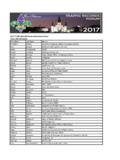Transcription of GUIDE SPECIFICATIONS FOR TENNIS COURT …
1 GUIDE SPECIFICATIONS FOR. TENNIS COURT CONSTRUCTION. 1. INDEX. Page INTRODUCTION 1. SECTION TENNIS COURT CONTRACTORS 1. Selection Criteria 1. General 1. Developing Working Practices 1. Selection of TENNIS COURT Contractor 1. SECTION CONDITIONS FOR CONSTRUCTION2. General 2. Contract Documents 2. Scope of Work 2. Permits 2. Guidelines for Site Preparation 2. Site Stripping and Clearance 2. Earthworks 2. Inspection and Testing 3. Finished Surface Levels 3. TENNIS COURT Orientation 3. Dimensions 3. COURT Lines 3. COURT Area Dimensions 3. Design Gradients 4. General Landscape Considerations 4. SECTION COURT CONSTRUCTION 4. 2. General 4. Red Porous Surface 4. Subgrade Drainage System 4. Drains 4. Trenches 5. Sump Pit 5. Surrounding Edging 5. Concrete and Solid Brick 5. Concrete Foundation 5.
2 Base Layer 6. Subsurface Layers 6. Red Porous Surfacing Layer 6. Lines 6. Maintenance 6. Initial Maintenance 6. Regular Maintenance Requirements 7. Maintenance Equipment Items Considered Standard 7. Synthetic Grass 8. Base Requirements 8. Product SPECIFICATIONS 8. Seaming Tolerances 8. Sand Infill 9. Maintenance 9. General 9. Potential Problems 9. 3. Recommended Maintenance Procedure 9. Recommended Treatments 9. (a) Cleansing Treatments 10. (b) Chemical Treatments 10. Acrylic Surfaces 10. General 10. Siteworks 10. Baseworks Preparation 10. Asphalt 10. Concrete 12. Drainage 12. Acrylic Surfacing 12. General 13. Asphalt 13. Concrete 13. Points to Note 13. SECTION BASE OPTIONS 13. Asphalt Base 13. General 13. Preparation of Subgrade 13. Installation of Concrete Border 14.
3 Installation of Crushed Rock 14. Prime 14. Hot Mix Asphalt 15. Concrete 15. 4. Preparation of Sub Base 15. Polythene 15. Installation of Reinforcement 16. Installation of Concrete 16. Joints 16. Synthetic Grass 16. Synthetic Acrylic 16. Bitumen Seal 16. General 16. Preparation of Sub Grade 17. Installation of Concrete Border 17. Installation of Crushed Rock 17. Crushed Rock Base 18. Prime 18. Hot Mix Asphalt 18. SECTION FENCING 19. Supply Requirements 19. Minimum Dimensions 19. Fittings 19. Cables 19. Chainwire 19. Installation Requirements 19. Post Centres 19. Footings 20. Support Rails and Stays 20. 5. General 20. Fittings 20. Cable 20. Chainwire 20. Tieing of Fence Cables, Chainwire and Rails 21. Post Colour 21. SECTION LIGHTING 21. General 21. The Tungsten Halogen System 21.
4 The Metal Halide System 22. SECTION ACCESSORIES 22. Net Posts 22. Net 22. Net Centre Strap 22. SECTION TENNIS COURT DRAW CURTAINS 22. General Description 22. Net Material & Manufacture 22. Support Structures 23. 6. INTRODUCTION. SECTION TENNIS COURT CONTRACTORS. Selection Criteria. General. Since building or resurfacing one or more TENNIS courts is not only relatively expensive but also a long time investment, special care should be taken in the selection of professionals involved in the project. Developing Working Practices. In the construction of a TENNIS COURT , there are many instances where problems relating to slope, layout, orientation, and the like are such that to proceed without the advice and experience of a member of the TENNIS COURT and Sports Field Builders Association of Australasia, experienced in TENNIS COURT design would be unwise.
5 Therefore the main factors which need to be considered in the development and use of suitable SPECIFICATIONS include: (a) proper COURT size;. (b) orientation of courts;. (c) slope and drainage of courts;. (d) base and construction materials;. (e) type and speed of surface, and (f) general information on lighting, fencing, nets, net posts, windscreens, maintenance and resurfacing. Selection of TENNIS COURT Contractor. Once working SPECIFICATIONS have been developed, a qualified contractor should be selected. Consideration of the following factors is recommended: (a) Submissions should be based on similar SPECIFICATIONS . (b) The contractor should be knowledgeable about and have had experience in dealing with slope, drainage, base materials, type of surfaces, lighting, fencing, nets, net posts, maintenance, resurfacing and acceptable tolerances.
6 (c) Upon request, the contractor should provide references. First hand inspection of courts built by the contractor is recommended. In checking these references, attention should be paid to: i. experience;. ii. workmanship;. iii. ability to meet schedules;. iv. financial responsibility, and 7. v. previous customers' general satisfaction. (d) The contractor should provide a guarantee against defective materials or workmanship. SECTION CONDITIONS FOR CONSTRUCTION. General. Prior to construction, the contract documents should be determined and signed by the respective parties. In these documents, the scope of work, related permits, site preparation details and TENNIS COURT orientation should be included and agreed upon. Dimensions and design gradients need also to be confirmed prior to the commencement of works, with general landscaping details to be considered and mentioned to clear up any uncertainties which may arise once works have commenced.
7 Contract Documents. The contract documents should consist of the TENNIS COURT & Sports Field Builders Association of Australasia Agreement, duly completed and signed by all parties prior to commencement of works. This agreement will include full detailed requirements relative to: (a) pegging out the site;. (b) access requirements;. (c) completion time;. (d) payment terms;. (e) insurance details, and (f) guarantees. Scope of Work. This should include all labour, materials, and equipment as agreed by all parties, and be attached to the contract documents. Permits. All permits and authorisations required for the construction as detailed in Scope of Works must be obtained prior to commencement, either by the TCASFBAA. Member or owner as detailed in the agreement, and this to be attached to the contract documents.
8 Guidelines for Site Preparation. Site Stripping and Clearance. Unless otherwise specified, grass, topsoil and other unsuitable materials shall be removed from the COURT area, and removed from the site. All trees and stumps are to be similarly removed, such areas backfilled and compacted as per Australian Standards. Earthworks. 8. Where it is necessary to raise the levels of all or part of the COURT area, such filled material should be free of organic and/or unsuitable material and shall be placed in layers not exceeding 250mm in depth. Each layer will be suitably compacted prior to the laying of the next layer, to a minimum Australian Standard of 95% standard compaction. The water content of the fill should be reduced by aeration or increased by adding water as necessary to achieve this required compaction.
9 Where the natural soil at the bottom of the sub-base course is stable, as evidenced by stability under construction equipment, hand auger or other exploration, base course materials can be placed on this soil. Soft clay areas can be stabilised by appropriate civil engineering techniques. The use of geotextile membranes may be considered for larger areas, Inspection and Testing. Compliance with these guidelines can best be determined by inspection and tested by a qualified engineer or technician. Responsibility for the cost of such inspection should be agreed upon in advance between the owner and the contractor. Finished Surface Levels. The proposed COURT levels should be detailed in the Scope of Works. The contractor should advise the client in writing if any alteration to such levels is required.
10 TENNIS COURT Orientation. The ideal COURT orientation is North-South. The location in respect of property boundaries, and neighbour residences should be fully discussed and detailed in the Scope of Works. Dimensions. COURT Lines. The playing line marking must be in accordance with the Australian Industry Standards, which is (length) x (width). The centre service line and centre mark line must be 50mm wide. All other lines except the base line may be 25mm-50mm wide. The base line may be 25mm-100mm wide. All measurements are to the outside of the lines. COURT Area Dimensions (fence to fence). The official Championship COURT area will be not less than: (length) x (width). For normal competition play, these dimensions may be reduced to not less than: (length) x (width). 9.





